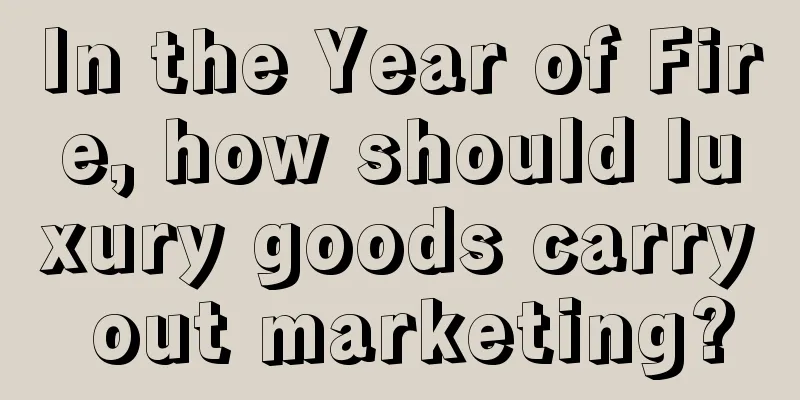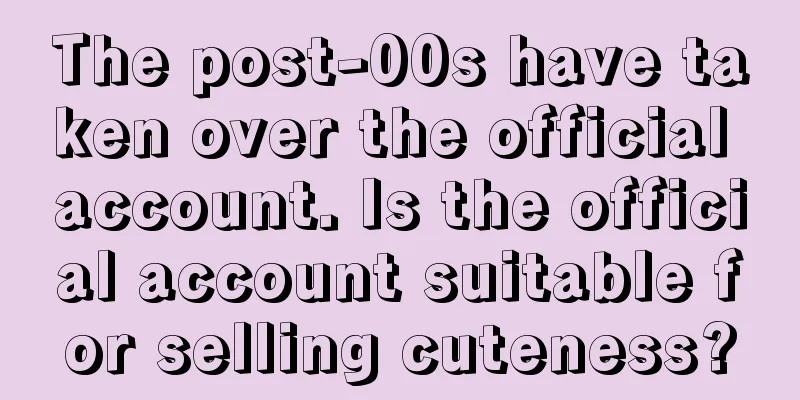In the Year of Fire, how should luxury goods carry out marketing?

The Chinese market has brought opportunities for rapid growth of luxury goods, but when brands want to make big plans, they will find that the market environment in China is different from other regions, and those successful strategies that have been tried and tested elsewhere may be completely ineffective here. In fact, the logic behind this is not difficult to understand. On the one hand, China’s luxury consumers are experiencing a “generational change”. People born in the 1990s and even younger in the 2000s have become the main force of luxury consumption. They have great differences from their predecessors in emotional needs, behavioral preferences and brand awareness. On the other hand, China's first- and second-tier cities have become the most digitalized regions in the world. Young people have watched online shows of GUCCI, Louis Vuitton, and PRADA a few years ago, and have also visited the "Dior and Art" exhibition with virtual partners. If you want to communicate with these emerging groups, you must update your communication strategy and reshape the communication environment. If you fail to grasp the changing trend, you will easily be eliminated in the new round of competition. According to the data disclosed by iResearch, we found that the luxury industry seems to have found a way forward when facing challenges. More and more luxury brands are accelerating the construction and layout of digital platforms, hoping to open up communication channels through community websites and video websites, where young people gather. Brands have also made many attempts at "localization", such as Louis Vuitton opening a pop-up space in Shanghai on the banks of Suzhou River, and LOEWE launching a new series of products inspired by ancient Chinese jade. More and more brands are beginning to crack this round of challenges in their own way. 01 Diversification of consumer groupsConsumption logic has quietly changed The degree of younger luxury consumption in China is already at the forefront of the world. Behind the generational change is the reshaping of consumption concepts and consumer portraits. In the past, when talking about luxury marketing, the "Veblen effect" was always mentioned, that is, the higher the price of a product, the more popular it is. Many consumers buy luxury goods not only for their function and quality, but also to satisfy the need to "show off". However, different groups now show diversified characteristics in luxury consumption, and changes in consumer mentality have caused these effects to lose their original influence. In the 2024 "Luxury Trend White Paper & Crowd Inspiration Atlas" jointly released by Xiaohongshu and VOGUE Business, the two parties have personalized the classification of luxury consumers based on the in-depth understanding of the content preferences, luxury consumption attitudes, selection opportunities and purchase considerations of the crowd, from which we can get a glimpse of the changes in consumption logic. First, light consumers pay more attention to self-pleasure and personalized brand experience. Driven by the Internet and social media, the concept of "pleasing oneself" has been continuously strengthened, and consumers regard luxury goods as gifts to reward themselves. When choosing luxury goods, they tend to choose products and services that are in line with their personal interests and brands. At the same time, they pay attention to the fit between luxury goods and personal values, hoping to express their self-worth and uniqueness through luxury goods. Secondly, heavy consumers make more rational decisions, and the quality-price ratio becomes a key consideration. Analysis of consumer stickiness shows that although the heavy consumer group (annual consumption of more than 300,000 yuan) only accounts for 11% of the total customer base, it contributes 40% of the market share. Today's new middle class generally has higher education and makes more rational decisions. They no longer simply regard luxury goods as a symbol of showing off status and wealth, but pay more attention to the quality and practicality of luxury goods, and begin to evaluate the quality-price ratio of different luxury goods. 02 Targeted MarketingFind the right key to the market In fact, no matter how consumers in the luxury market change, the basic pattern of “light to medium users + heavy users” remains very stable. Although heavy users are relatively few in number, they contribute nearly half of the market share. Although the consumption frequency and amount of light and medium users are not as high as those of heavy users, they can influence more potential new customers and are the potential for brand business growth. We can discuss the marketing strategy of luxury goods in the Chinese market by analyzing the characteristics of these two groups. Light userFocus on innovative gameplay + emotional connection Most light users have not yet formed a strong preference for a certain brand and are still in the stage of adapting to different products and self-preferences. They pursue creative interactive content at the marketing level and attach more importance to the convenience of online purchases. The suggestions on social platforms have a great influence on them, which is why many luxury brands are actively transforming. In the past two years, many brands have put their big shows "online". For example, luxury fashion shows such as the GUCCI 2023 Spring/Summer Collection Show, the Louis Vuitton 2023 Spring/Summer Men's Aranya Show, and the PRADA 2023 Spring/Summer Women's Fashion Show have been launched one after another in the Tencent ecosystem. Tencent uses its multi-product matrix to increase exposure, reach high-value groups, and deliver "show language" through the combination of social + fashion, helping luxury brands create more highlights. At the same time, the UGC characteristics of social platforms can also help brands communicate with consumers. For example, potential consumers can make choices that are more suitable for them through notes and reviews on Xiaohongshu, and brands can also obtain real-time feedback from different groups through these interactions and understand consumers' true views on the products. Heavy usersFocus on brand quality + experience service In contrast, heavy users usually have higher brand loyalty. They have a detailed understanding of the brand's development history, cultural heritage, and product details of different styles. Their consumption decisions are not easily influenced by external social relationships. Therefore, they pay more attention to the brand's customer service details, brand experience and the expression of brand connotation. For this group, the marketing strategy that brands should adopt is very clear, that is, to strengthen the exclusive sense of omni-channel experience and to show the brand's unique style in a three-dimensional way. We found that several major luxury groups are reshaping their retail and service systems through full-scenario marketing and full-scenario retail. Transformation is not just about moving from offline to online, from large screens to small screens, but about integrating into a new ecosystem and following the behavioral trajectory and consumption logic in this ecosystem. Therefore, many successful luxury marketing cases are well integrated with the existing ecosystem within the platform. For example, in the Tencent ecosystem, brands can use mini programs to achieve in-depth interaction and exclusive privacy, and connect online and offline services through functions such as private live broadcasts and video consultants. Offline activities and documentaries created in combination with local aesthetics can also bring a more complete perception to heavy users. Final WordsIn fact, for a long time, luxury brands have been quite cautious about the advancement of marketing methods. On the one hand, luxury brands have a set of successful methods in traditional marketing, but if these methods are only moved online, it is difficult for the audience to feel the "sense of quality" and "sense of luxury" that the brand wants to convey. On the other hand, luxury goods are different from ordinary fast-moving consumer goods. They do not pursue short-term sales conversion, but the accumulation of brand potential, so many mature youth strategies are not applicable to them. However, after analyzing some marketing cases, it is found that many contents are actually supplements and synergies to the original contents, and many innovative ways of playing do not conflict with the brand's tone shaping. Under the dual influence of the macroeconomic environment and rational consumption concepts, the luxury industry will still face more challenges and opportunities in 2024. Especially in the unique Chinese market, brands must break the previous mindset and make more efficient marketing changes to achieve a real breakthrough. |
<<: The 618 shopping festival of “new e-commerce” is played differently
>>: How can collection companies provide good user experience?
Recommend
Can one person start Amazon? What are the conditions?
When people choose to do cross-border e-commerce o...
How many Wish accounts can one person register? What should I do if my Wish account is linked?
Wish is a relatively well-developed cross-border e...
108 Marketing Models That Strategists Must Know in 2023 (Version 11.0)
This article summarizes 108 classic business manag...
Is it necessary to distribute products on eBay? How many products should be uploaded every day?
The distribution model of eBay means that sellers ...
How often does Amazon generate organic traffic? What influences Amazon traffic?
Amazon merchants all know the importance of store ...
Are Amazon Outlets promotions effective? How do they work?
Merchants who run stores on Amazon often use outle...
How is the profit of Temu sellers calculated? How is the commission of Temu operators calculated?
Temu is a good cross-border e-commerce platform. F...
Xiaohongshu current limit detection method + ten reasons for current limit
This article focuses on the common problem of traf...
Taiwan Shopee Hi-Life shipping channel buyer side freight notice
Shopee recently released the latest notice on the ...
Why isn’t your brand marketing working?
In current brand communication, the conversion eff...
60,000 followers, 160,000 orders!
This article introduces the case of selling goods ...
What is an Amazon bank statement? What should I do if I need a bank statement?
Amazon sometimes verifies the seller's bank ac...
What are the requirements of Amazon platform for product main pictures? How to make Amazon main pictures?
In this highly competitive market, the main image ...
The “involutionary” world of e-commerce: Only by competing on services can there be a way out
The essence of all businesses is to serve people. ...
When Tik Tok puts a "tight ring" on anchors
The consequence of free posting on Douyin is frequ...









